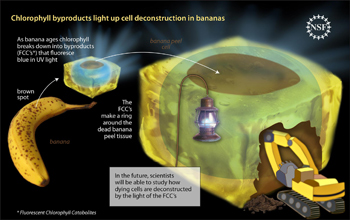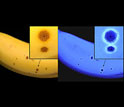News Release 09-170
Bananas Gone Bad Glow Blue in UV-Light
Holds promise for studying how organisms cleanse themselves of dying cells

Chlorophyll byproducts light up cell deconstruction in bananas.
September 9, 2009
This material is available primarily for archival purposes. Telephone numbers or other contact information may be out of date; please see current contact information at media contacts.
Nicholas Turro of Columbia University, Bernhard Krautler of the University of Innsbruck, Austria and their colleagues have found that, as chlorophyll ages and begins to disintegrate in banana peels it does not change color in the spectrum of visible light we see. Instead, it glows blue when observed under ultraviolet light.
While the light show adds a level of exoticism to the fruit in our eyes, and serves to attract a host of potential consumers in the eyes of insects and other animals who can appreciate the UV, the display is equally exciting to chemists. Because the glowing molecules occur in close proximity to dying tissue, they promise to be a literal beacon for the further study of the way organisms cleanse themselves of dying cells, or programmed cell death. A well known and poorly understood condition in which programmed cell death malfunctions is cancer.
Turro and his colleagues describe how ordinary brown spots that form on bananas as they transition from ripe to rotten, each show a glowing blue halo in UV, caused by the congregation of chlorophyll breakdown byproducts. Their research appears in the Proceedings of the National Academies of Science.
Chlorophyll is the molecule that makes much of the life on earth possible. It is the integral ingredient that allows plants to take in a mixture of carbon dioxide, water and sunlight and convert it to oxygen, sugars and starches. These are the same sugars and starches we eat every time we fix a salad, and the same oxygen that we breathe.
Chlorophylls are ubiquitous on earth and their life processes are clearly visible even from outer space. As chlorophylls age and break down they can do so in spectacular displays. The most familiar of these is the red and yellow of fall foliage. However, not every chlorophyll molecule that breaks down results in red or yellow.
"This work brings to fruition some of the remarkable principles of fundamental organic photochemistry harvested from more than four decades of Professor Turro's research at Columbia" says George Kenyon, program officer in the National Science Foundation's Chemistry Division.
-NSF-
-
A ripe banana is yellow with brown spots in visible light, but glows blue in UV.
Credit and Larger Version
Media Contacts
Dana W. Cruikshank, NSF, (703) 292-7738, email: dcruiksh@nsf.gov
Program Contacts
George L. Kenyon, NSF, (703) 292-4943, email: gkenyon@nsf.gov
Co-Investigators
Nicholas J. Turro, Columbia University, (212) 854-2202, email: njt3@columbia.edu
The U.S. National Science Foundation propels the nation forward by advancing fundamental research in all fields of science and engineering. NSF supports research and people by providing facilities, instruments and funding to support their ingenuity and sustain the U.S. as a global leader in research and innovation. With a fiscal year 2023 budget of $9.5 billion, NSF funds reach all 50 states through grants to nearly 2,000 colleges, universities and institutions. Each year, NSF receives more than 40,000 competitive proposals and makes about 11,000 new awards. Those awards include support for cooperative research with industry, Arctic and Antarctic research and operations, and U.S. participation in international scientific efforts.
Connect with us online
NSF website: nsf.gov
NSF News: nsf.gov/news
For News Media: nsf.gov/news/newsroom
Statistics: nsf.gov/statistics/
Awards database: nsf.gov/awardsearch/
Follow us on social
Twitter: twitter.com/NSF
Facebook: facebook.com/US.NSF
Instagram: instagram.com/nsfgov



